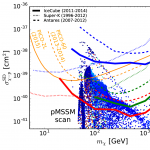Paper of the month: Search for annihilating dark matter in the Sun with 3 years of IceCube data

January 18, 2017 by tiinatimonen
Did you know that the neutrino telescope IceCube is used to search for hints of dark matter? In the standard model of our galaxy all the luminous objects, such as stars and planets, which compose the Milky Way’s disc, are embedded into a spherical halo of dark matter. The existence of dark matter was first proposed to explain the rotation curves of galaxies: from the visible mass in the galaxy one can infer its gravitational potential and from that deduce the average velocity of a star at some distance from the galactic center. However, it was found that stars, especially those far out of the galactic centre, move much faster than predicted. Scientists concluded that there is more matter around in our galaxy than those we see with our telescopes and dubbed this ominous substance dark matter. Alternative approaches exist to explain this discrepancy (see for example last month’s paper) but dark matter is by far the most common one. Since then, dark matter has been searched for intensively and particle physicists tried to come up with an explanation, what dark matter could be made of. One of the most common theories are the so called ‘Weakly Interacting Massive Particles (WIMPs)’.
This month’s paper searches for WIMP signals by the following reasoning: If the Sun travels through an halo made of WIMPs, some of them will be captured in the Sun’s gravitational potential and eventually sink into the Sun’s core, where they can pair annihilate into Standard Model particles producing neutrinos. If this process goes on for long enough it will reach an equilibrium where as many WIMPs annihilate as new ones reach the Sun’s core. The Sun is a very dense environment, made out of protons and electrons and most of the created particles will interact again immediately and therefore will never be able to leave the Sun. However the situation is different for neutrinos: because they interact so weekly they can leave the Sun and travel to the Earth, where we can try to detect them.
This is where the IceCube detector comes into play. IceCube is a neutrino Cherenkov detector, located at the South Pole. If a neutrino travels through the ice near the detector it might interact with its protons and neutrons and can thereby create charged particles, which can travel faster than light in ice. Whenever a charged particle travels in a medium with a speed faster than the speed of light in that medium, it emits light, called Cherenkov radiation. Scientists equipped a cubic-kilometre of ice at the South Pole between a depth of 1450m and 2450m with strings of photomultipliers to be able to detect the light created when a neutrino interacts with the ice and thus, indirectly, detect the neutrino, its energy and the direction it came from.
High-energetic muons can also be originated when cosmic rays hit the atmosphere and IceCube needs to be careful not to misinterpret those muons with the ones produced in the charged-current interactions of muon-neutrinos (and anti-muon-neutrinos). The trick is to use the Earth as a shield: muons can not traverse the Earth. However, there are also neutrinos created when a cosmic ray hits the atmosphere and of course those neutrinos have nothing to do with dark matter annihilation at the Sun’s core. Unfortunately there is no way to distinguish if a neutrino coming from the direction of the Sun is created by dark matter annihilation or a cosmic ray. What the analysis does, instead of looking at the Sun solely, is to compare rate of neutrinos from the Sun’s direction to those from all other directions.

Figure 1: Limits on the proton-WIMP cross section, compared to results from other neutrino detectors and direct detection experiments [1, 2, 3, 4]. The IceCube limits have been scaled up to the upper edge of the total systematic uncertainty band.
The analysis uses data collected during austral winters between May 2011 and May 2014 but finds no excess in events from the Sun’s direction. They use this result to derive an upper bound on the rate, at which dark matter co-annihilates and also on the proton-WIMP cross section, that is how strongly WIMPs interact with protons. Classically this cross section is split into a spin-dependent and an spin-independent part, depending on the nature of the interaction. Most current experiments are more sensitive to the spin-independent part and here the analysis does not give to much new information. The situation is different for the spin-dependent cross section where this paper finds the most stringent existing bounds for WIMPs heavier than 50 GeV as shown in Fig. 1. The solid red, green and blue lines correspond to bounds, derived in the paper, for different possible dark matter annihilation channels.
References
[1] S. Adrian-Martinez et al. [ANTARES Coll.]. Phys. Lett. B, 759(69), 2016.
[2] C. Amole et al. [PICO Coll.]. Phys. Rev. D, 93(052014), 2016.
[3] C. Amole et al. [PICO Coll.]. Phys. Rev. D, 93(061101), 2016.
[4] K. Choi et al. [Super Kamiokande Coll.]. Phys. Rev. Lett., 114(141301), 2015.
Text by Julia Stadler and Elena Perdomo


